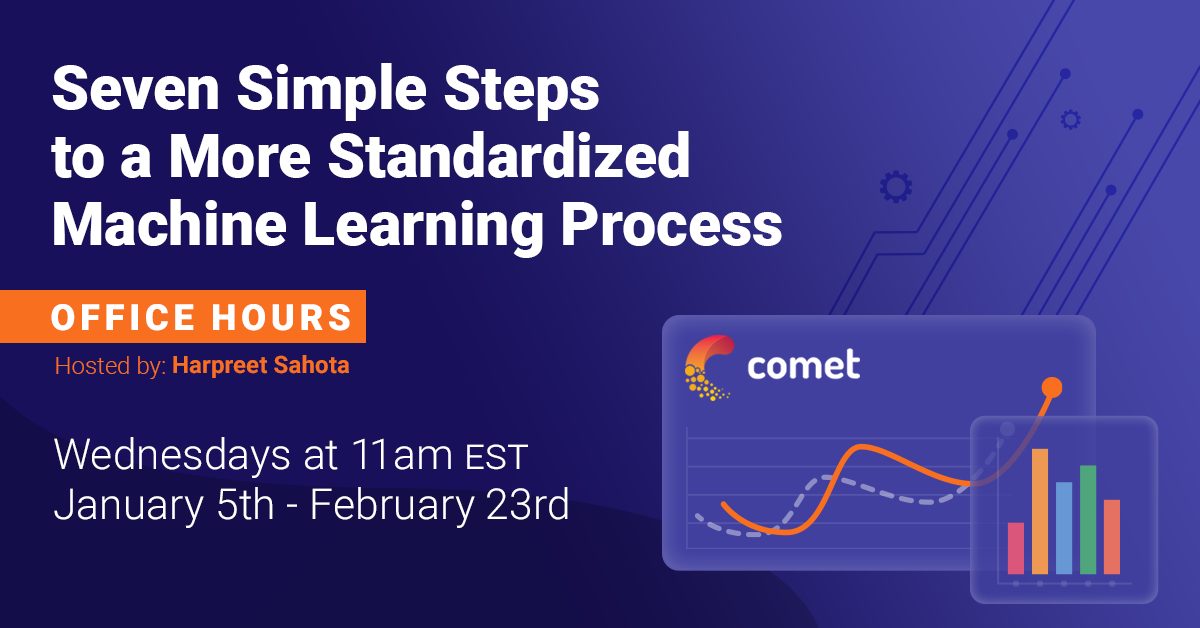Comet Office Hours: Recap for July 11, 2021
Welcome to another recap of the Comet ML Office Hours, powered by The Artists of Data Science!
Before we jump into this week’s recap, I wanted to let you know that these sessions now also stream live on LinkedIn, YouTube, and Twitch. Be sure to follow Harpreet Sahota on those channels to tune in.
But also, don’t be shy! These events are free to attend, and there’s always room to ask question you might have, jump into the conversation, and learn from your fellow data scientists and machine learners.
This week, the group covered another range of interesting topics, but I’m going to focus on three threads here:
- An exploration of what has drawn us to the fields of data science and machine learning
- A discussion centered on how focusing too much on communicating “business impacts” via your resume can be distract from the core strengths of your portfolio work
- And something a bit more philosophical—tips and practices for boosting creativity
As a reminder, we’d love to see any and all of you at these hourlong sessions—so feel free to register for upcoming Office Hours sessions here!
As always, there’s a lot more in the full session (which you can find on Harpreet’s YouTube channel), so be sure to check it out, alongside all of Harpeet’s other excellent content.
What draws you to data science and machine learning?
Harpreet kicked things off with a round-robin discussion topic for the group that really dug to the core of why we all attend these sessions (and others like it). Here’s a quick list summarizing a few of the reasons provided, but be sure to check out the full clip for some of the reasoning and insights.
- A real-world application for interest and skill in math
- Predicting the future and having people take actions based on those predictions
- A strong and vibrant community
- The technical and creative challenges the field offers
Data science resumes and the importance of communicating “business impacts”
With evidence mounting that many data science projects fail, and that extracting business value out of these projects takes a lot of strategic planning and execution across teams, there seems to be an increased focus on job seekers being able to prove that they understand how to communicate the potential business impacts of their DS/ML work.
While it’s certainly true that communicating about what you do—and tying that communication to how these projects affect an organizations KPIs or other bottom-line metrics—narrowing your project portfolio’s focus too much on metrics like revenue generation can actually detract from your candidacy. This is especially true if the projects you’re working on are more focused on R&D, the feasibility of DS/ML for a given project, or suggest longer-term changes to product or organization strategy.
In this exchange, Harpreet teases out this distinction, in an attempt to reorient our focus on better communication, project structure, and depth of thought when it comes to how we present our projects to potential employers and within our resumes.
Tips for boosting creativity
One thing I love about these office hours is that the group always manages to weave in something a bit more abstract, or at least something that’s more tangentially related to the field of data science.
This week, that came in the form of a question about ways to boost creativity and make the practice of it more habitual. The full video clip is worth a complete watch for those who struggle with making time and space for free, creative thought.
Resources Mentioned
In addition to the wonderful back-and-forths throughout the session, there were a whole lot of interesting resources mentioned, both by Harpreet and many of the attendees. Here’s a quick list, in case you’d like to check out what is capturing the community’s attention.
- Deep Learning Illustrated, John Khron
- Thinking in Bets, Annie Duke
- Ultralearning, Scott Young
- “The Ultimate Guide for Becoming and Idea Machine“, James Altucher
- The Artist’s Way, Julia Cameron
- The Fabric of Reality, David Deutsch
- The Creativity Leap, Natalie Nixon
- The Ezra Klein Show, Interview with Jeff Tweedy of Wilco
Enjoy the Conversations Above? Join Us!
We run these virtual Office Hours every Sunday at 12pm ET (New York, NY). Completely free to attend and participate, and we’d love to see any and all of you there, help address any questions you might have, and just hang out and talk all things data science and machine learning!
Register for Comet Office Hours
One last thing…
We recently launched The Comet Newsletter, which offers a weekly inside look at all things data science and ML, featuring expert takes and perspective from our team. We have big things planned for both Office Hours and the newsletter, so be sure to subscribe if you haven’t already!
Subscribe to the Comet Newsletter
